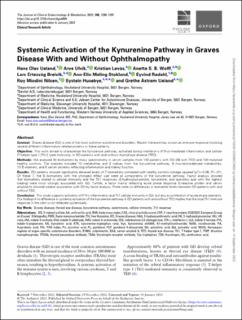Systemic Activation of the Kynurenine Pathway in Graves Disease With and Without Ophthalmopathy
Ueland, Hans Olav; Ulvik, Arve; Løvås, Kristian; Wolff, Anette Susanne Bøe; Breivik, Lars Ertesvåg; Stokland, Ann-Elin Meling; Rødahl, Eyvind; Nilsen, Roy Miodini; Husebye, Eystein Sverre; Ueland, Grethe Åstrøm
Peer reviewed, Journal article
Published version
Permanent lenke
https://hdl.handle.net/11250/3091389Utgivelsesdato
2023Metadata
Vis full innførselSamlinger
- Import fra CRIStin [3581]
- Institutt for helse og funksjon [568]
Originalversjon
Journal of Clinical Endocrinology and Metabolism (JCEM). 2023, 108 (6), 1290-1297. 10.1210/clinem/dgad004Sammendrag
Context
Graves disease (GD) is one of the most common autoimmune disorders. Recent literature has shown an immune response involving several different inflammatory related proteins in these patients.
Objective
This work aimed to characterize the kynurenine pathway, activated during interferon-γ (IFN-γ)–mediated inflammation and cellular (T-helper type 1 [Th1] type) immunity, in GD patients with and without thyroid eye disease (TED).
Methods
We analyzed 34 biomarkers by mass spectrometry in serum samples from 100 patients with GD (36 with TED) and 100 matched healthy controls. The analytes included 10 metabolites and 3 indices from the kynurenine pathway, 6 microbiota-derived metabolites, 10 B-vitamers, and 5 serum proteins reflecting inflammation and kidney function.
Results
GD patients showed significantly elevated levels of 7 biomarkers compared with healthy controls (omega squared [ω2] > 0.06; P < .01). Of these 7, the 6 biomarkers with the strongest effect size were all components of the kynurenine pathway. Factor analysis showed that biomarkers related to cellular immunity and the Th1 responses (3-hydroxykynurenine, kynurenine, and quinolinic acid with the highest loading) were most strongly associated with GD. Further, a factor mainly reflecting acute phase response (C-reactive protein and serum amyloid A) showed weaker association with GD by factor analysis. There were no differences in biomarker levels between GD patients with and without TED.
Conclusion
This study supports activation of IFN-γ inflammation and Th1 cellular immunity in GD, but also a contribution of acute-phase reactants. Our finding of no difference in systemic activation of the kynurenine pathway in GD patients with and without TED implies that the local Th1 immune response in the orbit is not reflected systemically.

